The adhesive properties of a Silicone Breast Patch are paramount to its functionality and user satisfaction. These patches, designed to provide a seamless and comfortable coverage for various occasions, rely heavily on their ability to adhere securely to the skin without causing discomfort or irritation. The question of whether Silicone Breast Patches are prone to falling off is a common concern among potential users, and it is essential to address this concern with a comprehensive understanding of the factors that contribute to their adhesive performance.
Firstly, the material composition of Silicone Breast Patches plays a significant role in their adhesive strength. Silicone, known for its flexibility and skin-friendly properties, is an ideal choice for creating a strong bond with the skin. The adhesive layer on these patches is specifically formulated to provide a secure grip without causing skin irritation, even for those with sensitive skin. This formulation is tested to ensure that it maintains its adhesive properties over time, providing consistent performance throughout the life of the patch.
Secondly, the surface area of the Silicone Breast Patch contributes to its adhesive capabilities. Larger patches have a greater contact area with the skin, which naturally results in a stronger bond. Manufacturers often design patches with an optimal balance between size and coverage to ensure that they stay in place without the need for constant readjustment.
Thirdly, the condition of the skin can affect the adhesion of Silicone Breast Patches. Clean, dry skin provides the best surface for the adhesive to bond with. Users are advised to clean the area where the patch will be applied with mild soap and water and to allow it to dry completely before application. This simple preparation step can significantly enhance the adhesive performance of the patch.
Environmental factors, such as temperature and humidity, can also influence the adhesive strength of Silicone Breast Patches. In hot and humid conditions, the adhesive may become less effective, increasing the likelihood of the patch slipping or falling off. To counteract this, users can consider applying a light dusting of cornstarch or a similar product to the skin before application, which can help absorb excess moisture and create a more secure bond.
The design of the Silicone Breast Patch also plays a role in its adhesive performance. Some patches feature a textured surface or additional adhesive strips to enhance their grip on the skin. These design elements can provide an extra layer of security, ensuring that the patch stays in place even during physical activity.
Moreover, the proper application technique is crucial for maximizing the adhesive strength of Silicone Breast Patches. Users should follow the manufacturer's instructions for application, which typically involves peeling off the protective layer and pressing the patch firmly onto the skin. Applying even pressure and smoothing out any wrinkles or air bubbles can help to ensure a strong bond.
Lastly, the frequency of use and the duration for which the Silicone Breast Patch is worn can impact its adhesive properties. While these patches are designed for repeated use, excessive wear or leaving them on for extended periods may cause the adhesive to weaken over time. To maintain optimal adhesion, it is recommended to follow the manufacturer's guidelines on usage and to replace the patches as needed.
In conclusion, the adhesive strength of Silicone Breast Patches is a multifaceted attribute influenced by material composition, patch size, skin condition, environmental factors, design elements, application technique, and usage frequency. By understanding these factors and taking the necessary steps to optimize adhesion, users can enjoy the benefits of Silicone Breast Patches without the concern of them falling off. Manufacturers continue to innovate and improve the formulations and designs of these patches to ensure that they provide a reliable and comfortable solution for a variety of needs.
